|
|
|
Sort Order |
|
|
|
Items / Page
|
|
|
|
|
|
|
| Srl | Item |
| 1 |
ID:
167369
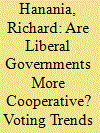

|
|
|
|
|
| Summary/Abstract |
Among both elites and the mass public, conservatives and liberal differ in their foreign policy preferences. Relatively little effort, however, has been put toward showing that, beyond the use of force, these differences affect the day-to-day outputs and processes of foreign policy. This article uses United Nations voting data from 1946 to 2008 of the five major Anglophone democracies of the United States, the United Kingdom, Canada, Australia, and New Zealand to show that each of these countries votes more in line with the rest of the world when liberals are in power. This can be explained by ideological differences between conservatives and liberals and the ways in which the socializing power of international institutions interact with preexisting ideologies. The results hope to encourage more research into the ways in which ideological differences among the masses and elites translate into differences in foreign policy goals and practices across governments.
|
|
|
|
|
|
|
|
|
|
|
|
|
|
|
|
| 2 |
ID:
157510
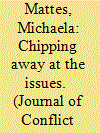

|
|
|
|
|
| Summary/Abstract |
Disputants might resolve their disagreements in a piecemeal fashion, addressing a subset of the issues at a time. How viable is such a strategy? I argue that partial settlements signal the desire to resolve disagreements and can lay the foundation for additional cooperation by building trust and/or demonstrating the benefits of dispute resolution. As a result, partial settlements should be associated with the resolution of remaining disagreements. Yet, scholars have questioned whether pursuing a piecemeal approach may be more harmful than helpful, and a systematic empirical test of these competing predictions is necessary. Using data from worldwide territorial claims between 1919 and 2001, I find a strong positive correlation between partial settlements and comprehensive dispute resolution. In the shorter run, partial settlements are also associated with an increased likelihood for peaceful negotiations, but there is only limited evidence that they reduce conflict before all aspects of the claim are resolved.
|
|
|
|
|
|
|
|
|
|
|
|
|
|
|
|
| 3 |
ID:
173765
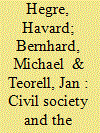

|
|
|
|
|
| Summary/Abstract |
We theorize that three distinct structures of democratic constraint explain why more democratic dyads do not engage in military conflict with each other. We build on earlier theories that focused on electoral and horizontal accountability. We add a new dimension—the social accountability provided by an active civil society. Using several new measures from the Varieties of Democracy (V-Dem) data set, we stringently test these explanations. We find social accountability to be the strongest and most consistent predictor of nonbelligerence in dyads, that horizontal accountability is still important, but that the independent role of electoral accountability has been somewhat overstated. However, we do find that social and electoral accountability work strongly together, to make for an even greater effect. The finding is robust to a range of specifications and in the face of controls for contending theories that challenge the democratic peace (e.g., the capitalist and territorial peace theories).
|
|
|
|
|
|
|
|
|
|
|
|
|
|
|
|
| 4 |
ID:
177017


|
|
|
|
|
| Summary/Abstract |
Studies of the effect of past actions have focused on yielding without a fight. What happens, however, when states fight and lose? This article assesses the effect of defeat on a state’s behavior and finds that recently defeated states are more likely to initiate disputes than are undefeated or victorious states or states that fight to a draw. This aggression comes at the expense of states responsible for defeat and third-party states uninvolved in the original defeat. The analysis below examines the validity of five potential explanations for postdefeat aggression, including models rooted in failed political objectives, an emotional desire for revenge and reputation-building and finds evidence in support for the latter two. These existing mechanisms fail, however, to explain a key finding—the systematic targeting of weaker, third-party states—which, I argue, is best explained by a desire to bolster the state’s status and confidence in the aftermath of defeat.
|
|
|
|
|
|
|
|
|
|
|
|
|
|
|
|
| 5 |
ID:
193111
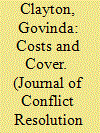

|
|
|
|
|
| Summary/Abstract |
Ceasefires are common in civil conflict. Yet we have surprisingly little comparative analysis of why and under what conditions they occur. A ceasefire provides temporary relief from the costs of conflict, but also generates its own costs. Building on this logic, we argue that conflict parties are more likely to accept the costs associated with a ceasefire when the conflict costs are greater, in particular, when: violence is intense; there are higher levels of ‘collateral damage’; and the parties lack international support. Second, we contend that ceasefires are also more likely in those periods in which the audience costs associated with entering into an arrangement are lower, specifically, when the parties have some form of ‘political cover’, such as during mediation. We find support for both arguments in an analysis of a new dataset capturing all ceasefire in civil conflict from 1989-2020, using a series of dyad fixed effect models.
|
|
|
|
|
|
|
|
|
|
|
|
|
|
|
|
| 6 |
ID:
193103


|
|
|
|
|
| Summary/Abstract |
This paper revisits the latest statistical evidence for the nuclear emboldenment thesis—nuclear-armed states are more likely to initiate military aggression than non-nuclear states—from (Bell and Miller 2015). If correct, their findings have important theoretical and policy implications regarding the effect of nuclear proliferation on international conflict. This paper shows, however, that Bell and Miller’s findings heavily rely on two important components of their statistical analysis: (1) using all state dyad observations, and (2) employing pooled regression models to analyze time-series-cross-sectional (TSCS) data. I argue that those components are based on questionable assumptions on heterogeneity in their dataset. Based on alternative strategies dealing with heterogeneity in dyadic data, my reanalysis shows that the emboldening effect of nuclear weapons is not as robust as originally claimed. Instead, I find the robust deterrent effect of nuclear weapons: nuclear-armed states are less likely to be targeted in military disputes. These findings highlight the need for careful application of quantitative methods to produce a more robust understanding of nuclear issues.
|
|
|
|
|
|
|
|
|
|
|
|
|
|
|
|
| 7 |
ID:
164173
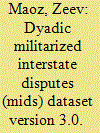

|
|
|
|
|
| Summary/Abstract |
We introduce the new, substantially updated, and revised version of the Dyadic Militarized Interstate Disputes (MIDs) dataset. We discuss the underlying logic of constructing dyadic MIDs and demonstrate that these operations generate significant differences between the actual occurrence and properties of MID dyads and those extracted from machine-generated programs such as EUGene, or from the MID participant dataset. We provide some descriptive measures of dyadic MIDs over the period of 1816 to 2010 and compare some of the key dyadic results on the correlates of MIDs using different datasets. We discuss the theoretical and empirical implications of our results.
|
|
|
|
|
|
|
|
|
|
|
|
|
|
|
|
| 8 |
ID:
132317
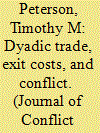

|
|
|
|
|
| Publication |
2014.
|
| Summary/Abstract |
Most studies of the link between dyadic trade and militarized conflict examine the extent of trade interaction. However, interaction measures do not account for the impact of cutting off trade (i.e., exit costs). In this article, I highlight the link between exit costs, the cost of conflict, and "the spoils of conquest," arguing that one state's exit costs are associated with higher incidence of dyadic conflict when its trade partner's exit costs are low. However, its exit costs become less aggravating-and eventually pacifying-as its trade partner's exit costs increase. I test this argument by estimating import demand and export supply elasticities, developing yearly exit cost measures for directed dyads, 1984-2000. Statistical tests confirm that unilaterally high exit costs are aggravating, but that jointly high exit costs are pacifying, a pattern most prominent for trade in strategic commodities.
|
|
|
|
|
|
|
|
|
|
|
|
|
|
|
|
| 9 |
ID:
153656


|
|
|
|
|
| Summary/Abstract |
While some borders are real firewalls against conflicts, others appear like tinder just waiting for the smallest spark. Only recently has research focused on the transnational perspective of conflict and current research has focused mostly on isolated aspects of this phenomenon. In this article, we provide a unified framework for conflict contagion that takes into account receiver, sender, dyad, and network effects. This is a novel perspective on conflict contagion, and our empirical results suggest that distinguishing between sender and receiver effects allows for a better understanding of spillover effects. We provide insights that especially excluded ethnic groups impact the risk of countries sending and receiving conflicts from its neighbors.
|
|
|
|
|
|
|
|
|
|
|
|
|
|
|
|
| 10 |
ID:
180221


|
|
|
|
|
| Summary/Abstract |
Our study compares the efficacy of mixed bargaining strategies to strict coercion or accommodation. While mixed strategies can be approached from different conceptual angles, we focus on flexible and/or firm postures as signaling properties of bargaining. In our theory and empirical analysis, we show that the combination of firmness with flexibility on both sides, without necessarily scripted rules as in tit-for-tat, leads to peaceful resolution without unilateral concessions. Its opposite, resolute firmness is unlikely to make the opponent yield, as assumed in influential literature of the traditional canon. If anything, war is most likely when both sides opt for it. We provide the theoretical rationale for these expectations, which are validated in our empirical analysis of the ICB crisis dataset for the 1918 to 2015 period. Our study also points to the bargaining process as a potential causal mechanism between democracy and peace, and therefore has relevant implications for several research strands.
|
|
|
|
|
|
|
|
|
|
|
|
|
|
|
|
| 11 |
ID:
154743
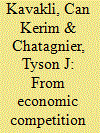

|
|
|
|
|
| Summary/Abstract |
The vast majority of the extant literature on trade and conflict focuses on bilateral trade to determine whether commerce has a pacifying effect upon pairs of states. We argue that this focus neglects a critical role of international trade: creating tension between states that sell similar goods to the global market. We consider this role explicitly and operationalize its effects empirically. Using commodity-level trade data from 1962 to 2000, we show that countries that produce and sell similar goods are generally more likely to fight, even after we take into account their bilateral trade ties and institutional membership in the global economic system. Our findings are robust to numerous alternative specifications and suggest a strong relationship between economic competition in the global market and military conflict between states.
|
|
|
|
|
|
|
|
|
|
|
|
|
|
|
|
| 12 |
ID:
147698


|
|
|
|
|
| Summary/Abstract |
In canonical accounts of war, conflict outcomes are inherently uncertain. Contesting literatures posit that this uncertainty, arising from stochastic elements of the war-fighting process, may induce conflict due to greater risks of miscalculation or foster peace by breeding caution. We theorize that states, on average, exhibit prudence when confronting greater uncertainty. Despite its conceptual importance, extant proxies for uncertainty at various levels of analysis—such as polarity, balance of power, system concentration, and dyadic relative capabilities—are imprecise and theoretically inappropriate indicators. To overcome this shortcoming, we theorize the conditions that elevate the magnitude of uncertainty over conflict outcomes and introduce a novel measure that captures this uncertainty within any k-state system. Through extensive empirical analysis, we confirm uncertainty’s pacifying effect and show how this effect operates at different levels of analysis
|
|
|
|
|
|
|
|
|
|
|
|
|
|
|
|
| 13 |
ID:
161603


|
|
|
|
|
| Summary/Abstract |
Power transition theory (PTT) has had a progressive research program for more than half a century. In spite of this, one of its key concepts, satisfaction, has remained undertheorized. A compelling theory explaining why growth would make some states dissatisfied in the context of power transitions and others satisfied has not been articulated. It is argued here that satisfaction must be theorized at two levels of analysis: the global and the dyadic. The key to distinguishing satisfied versus dissatisfied states at the global level lies in specifically differentiating between the structural effects of changing power and the satisfying effect of increasing wealth. At the dyadic level, conflict over territory creates a perfect storm of state dissatisfaction. The study develops a theoretical framework for a multilevel understanding of satisfaction and its impact and tests it across politically relevant dyads from 1950 to 2001. The evidence strongly supports the hypotheses.
|
|
|
|
|
|
|
|
|
|
|
|
|
|
|
|
| 14 |
ID:
107924


|
|
|
|
|
| Publication |
2011.
|
| Summary/Abstract |
While economic sanctions are commonly regarded as nonviolent coercive diplomacy, scholars show that senders-particularly democratic senders-are actually more likely to use military force against the targets of their sanctions. In this article, the authors extend this connection between sanctions and military action by arguing that countries targeted with third-party economic coercion are more likely to be targets of dyadic militarized violence from states not involved in the sanctions. The act of sanctioning, the authors argue, lowers the prohibitions to use violence against the sanctioned state by others. Empirical analysis of dyadic data from 1914 to 2000 shows that, within directed dyads, militarized interstate dispute (MID) initiation is more likely when the potential target of conflict is sanctioned by third-party states, particularly when the sanctioning state is a large democracy.
|
|
|
|
|
|
|
|
|
|
|
|
|
|
|
|
|
|
|
|
|